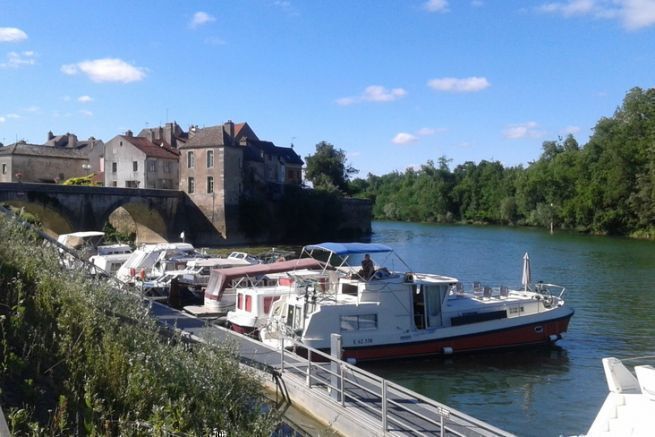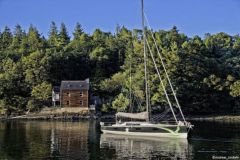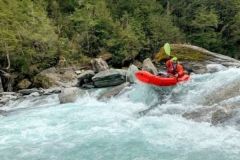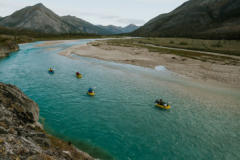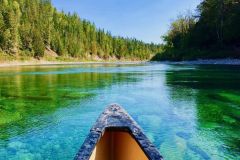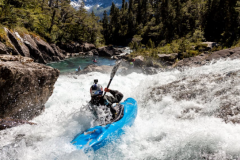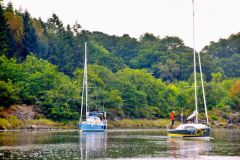The Saône River, which may be called the "Saône" or the "Grande Saône", is a 219 kilometer-long stretch of water that winds its way through the countryside of this southeastern part of France. Alternating between large agricultural areas downstream of Châlons-Sur-Saône and forests upstream, the river offers easy and widely marked navigation.
Author of tourist guides, boater and lover of his region, Philippe Costeur will guide us on this section and will advise us on good places to eat, rest or just let time pass on this long section which will bring us from the peaceful Saint-Jean-De-Losne to the boiling Mâcon.
A river of cargo traffic above all
" The Saône is a large gauge river past Saint-Jean "begins Philippe " which widens as you go towards Lyon, further south. "
Indeed, the five locks that regulate the water levels are all, without exception, designed for convoys of up to 190 meters in one piece and 12 meters wide. " All these locks are automated and there are lock keepers at each one "The guide laughs.
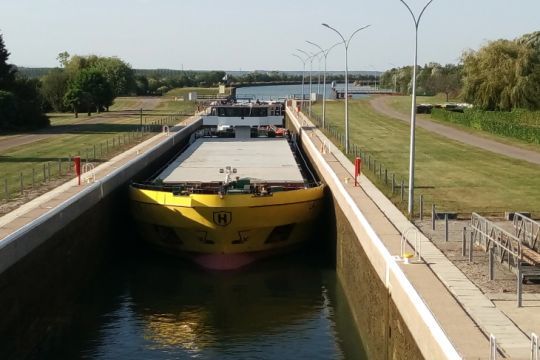
Indeed, even with a 20-meter boat, the crossing of a lock of such a dimension is a most impressive occasion!
Moreover, each of these locks is monitored by VHF ( canals are indicated several kilometers before the structure ) and by lookout. " Even though the lock keepers are always responsive, priority is given to commercial traffic. It is recommended to contact the lock about 3 or 4 kilometers before approaching it, to announce yourself and to check if there is any docking in progress. If there is, as a boater, it is better to go to the waiting pontoon - there is one for each lock - and wait until you can pass. "explains Philippe.
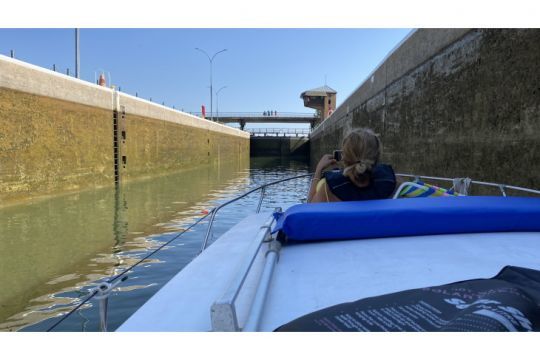
For the anecdote, it is not rare to see 165 meters long convoys or even passenger ships crossing these locks. Beautiful souvenir photos in perspective!
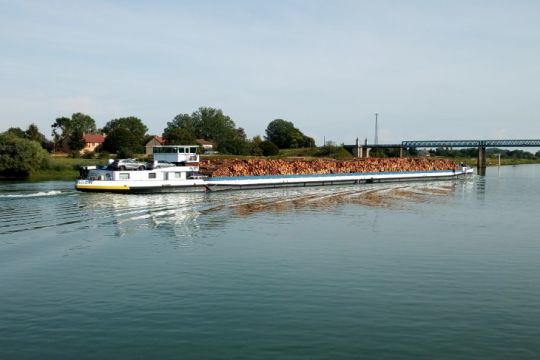
" On the whole, the Saône has a few places that have remained very wild, but the width of the river tends to give an impression of equipment and modernity which, in fact, is quite false, because one crosses particularly beautiful and varied landscapes "says Philippe. It must be recognized that the river serves some of the largest cities in the country and flows into the Rhone, in the capital of Gaul.
" More commercial traffic also means that the boat stops will be less wild than on the upstream portion of Saint-Jean "explains Philippe " forget the wild mooring here, it is even dangerous! "
Follow the channel and its rules
To combat silting of the river, a system of underwater walls ( the wattle and daub ) has been put in place. It is sometimes visible, sometimes not. But almost always present, along the navigation channel. Hence the need to be at twenty meters to the inside the beacons when they are present.
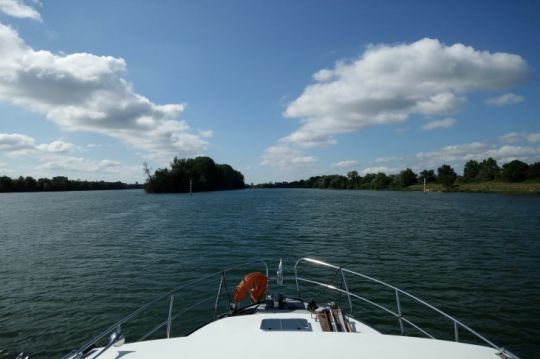
The principle is known to all river boaters. The green beacon ( left bank ) and the red tag ( right bank ) indicate a channel between them. Only one of these two markers indicates that the channel goes from this one to the opposite shore without pitfalls or danger. The absence of a marker indicates that there is no specific channel.
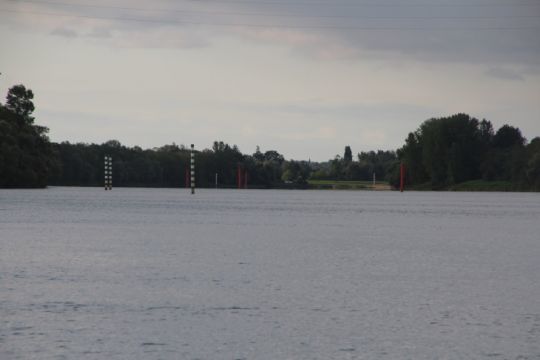
Many small villages during the navigation
" At the exit of Saint-Jean-De-Losne there is an old lock. It has no service, is only used as a boat storage and can, eventually, be used for a lunch stop "begins Philippe. It is followed by the deviation of Seur " a long straight line of 8 kilometers which does not present any major tourist interest, except to be limited to 15 km/h to pass the time more quickly ".
At KP 188, we pass the first of five locks on the river, at Seurre ( at the end of the eponymous straight line ). " The lock is located 300 meters from the city where there is a marina and a river stop. It is a very interesting city to visit. Do not miss the superb Bossuet house, built in 1504. It presents an original and really interesting architecture. "In town, in Seurre, you will find all the classic shops to stock up.
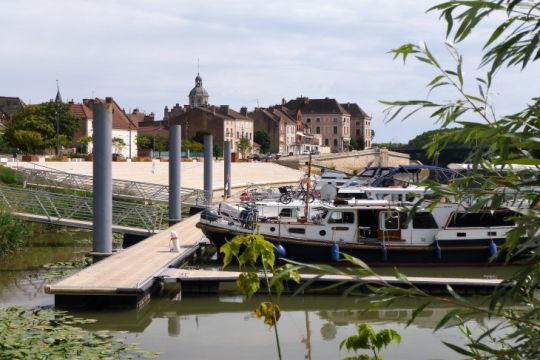
" After Seurre, it is possible to go back up to the town of Lechâtelet by leaving the Saône diversion canal that we were using "says Philippe. " You have to take the fork on the left just in front of the marina of Seurre and to go up on 8 kilometers to arrive there. There is a small marina and you can continue to the dam, it is a dead end. It is a really pleasant walk to make, very bucolic and calm "he recommends.
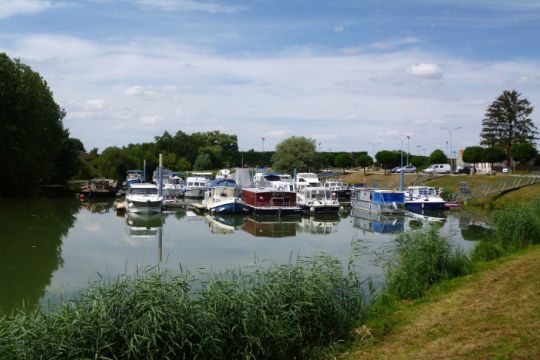
Let's go back to Seurre, and take the main course of the river.
At KP 175 is the Ecuelle lock, the second on the route.
At kilometer 167, here is Verdun-Sur-Le-Doubs " It is here that the Doubs and the Saône meet. The river is very sinuous here, it is necessary to take care because one crosses large convoys of goods! "alert Philippe.
If you go to the left - on the Doubs - and go up a few hundred meters, you will find the Verdun river stop. It is equipped with pontoons with water and electricity. " It is a pretty village to visit which offers all the services and shops. Be careful, you will have to turn back on the Doubs itself, because the small Doubs, which is very attractive when you are in the marina, is forbidden to navigation " says the specialist of the region.
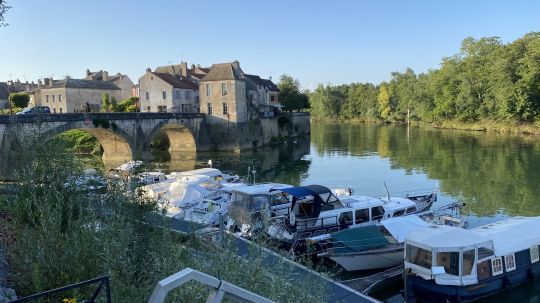
It is after Verdun-Sur-Le-Doubs that the course and the channel become clearly marked " And mandatory if you don't want any bad surprises "insists Philippe. As a reminder, navigation must be done at 20 meters inside the beacons for all users, the channel is guaranteed at 3.50 meters.
It is precisely in these channels that the wattle and daub are located, each year boaters come to hit them, the damage can be significant on the boats. " So, only one instruction, respect the channel "reminds the prudent boater.
" After Verdun, however, again a very winding and pleasant part of the Saône. Many big loops that you can take by taking your time and admiring the landscapes. It is a particularly pleasant area when you take your time. "

In Gergy, at kilometre point 159 " a river stop with electricity and water. There is room for 5 or 6 boats at most. It's a nice, relaxed place for a good rest stop."
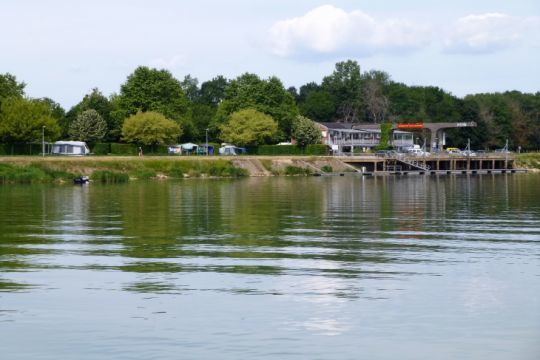
" As you approach Alleriot, around kilometer 150, look up and admire the beautiful houses built with their feet in the water along the Saône. If some of them have their own private pontoons, avoid mooring because some owners are reluctant to welcome you. It is better to pass, because wild mooring is very complicated. "
An informed boater is worth two!
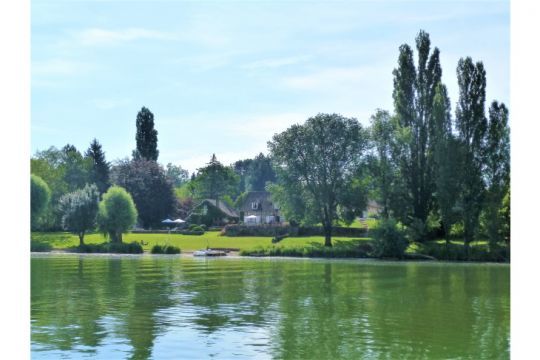
" At kilometre 145, turning to the right, you will reach the canal du center by passing the Crissey lock, one of the deepest locks in France, with a correction of 10.75 meters between the two rivers. Here, mooring on floating bollards and obedience to the lockkeepers' orders are a must! "insists Philippe.
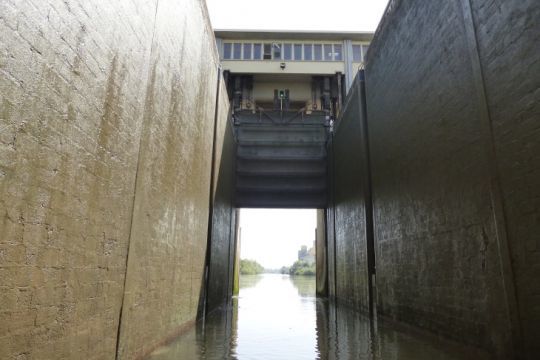
After Crissey, Chalons-Sur-Saône arrives very quickly. " As you enter Châlons, there is a sailing club with two private pontoons on the left, in the park of the Saint-Nicolas rose garden. But, traditionally, in Châlons, boaters moor at the marina which is on the side of the Île Saint Laurent. You can reach it by turning left on the arm of the Genise "recommends Philippe.
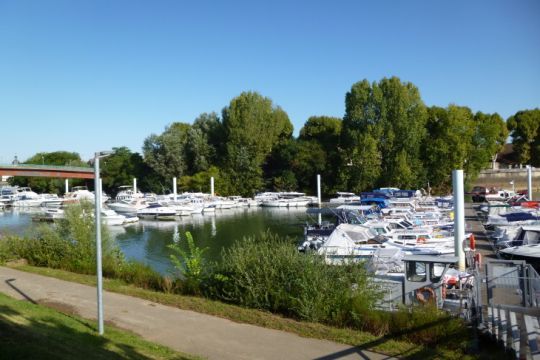
And for good reason: " A second marina exists in Châlons, a little further, quai Sainte Marie. It is at the prohibitive price of 30 euros the night ! ".
" A stop in Châlons is a must, the old town, the Saint-Laurent island and the parks are to be visited, it is a very beautiful city with a pleasant and historical atmosphere. "
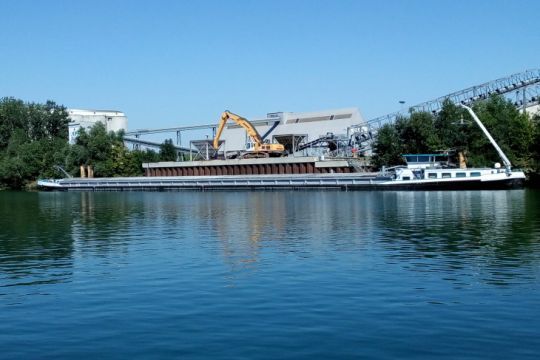
Past the big city, the Saône is bordered by more agricultural land, we cross less woods or forests.
When arriving at Gigny-Sur-Saône, at point 123, " there is a small nautical stop with all the services on the spot. There are few free places in summer, so it is better to leave Mâcon early enough not to be disappointed when arriving. There is a small restaurant, a shipyard and a boat rental company, Saône Bateaux. In town, there are a few shops and, above all, a pretty castle to see "says Philippe.
" A particularity of the Ormes lock at kilometre point 119. In case of flooding of the Saône, its gates are kept open and one can pass either over the dam or through the lock chamber. "
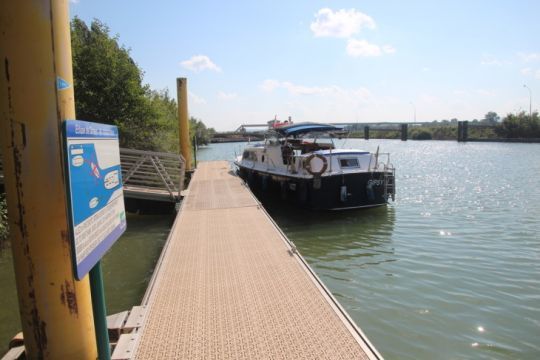
Warning, in case of flood however, the navigation may prove to be dangerous it is therefore better not to venture to attempt this passage, unless absolutely necessary.
Quickly appears the medieval city par excellence, Tournus. " At the point 112, we find the nautical stop of Tournus, located in full downtown. All the services are available there, water and electricity. For a short stop, there is a second boat stop along the North quay, upstream from the bridge of the departmental road. It offers no services, just bollards. "
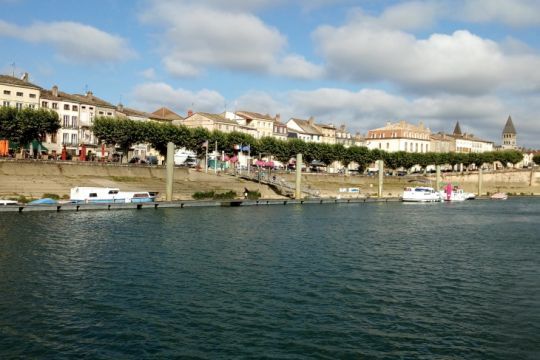
Be careful with the two halts present in Tournus, the parking is limited to 3 days maximum to avoid the boats "ventouses".

Continuing the descent, we will cross at kilometer 106 the Corne de Vachon, which will allow to join the Seille.
At Fleurville (PK 197) a launch is possible, just after the Vaux bridge. Still near the Vaux bridge, just downstream from the building, you must turn left through the lock that leads to the Vaux canal, which is four kilometers long. At the very end of the reach, in a dead end, there is a very nice marina that offers a maximum depth of 1.60 meters. " In Fleurville, you will find all the services and shops, it is a very pleasant little village and a stopover far enough away from the Saône to be calm and soothing "explains Philippe.
" Once back on the bed of the Saône, do not try to reach the pontoons on the left bank. A low wall is outcropping and is extremely dangerous for navigation. It is absolutely necessary to respect, in this zone, the markings and the rules of distance " alerts the local boater.
A few hundred meters further downstream is the island of Brouard, where one cannot disembark. Here, the river bed becomes narrower, so the passage is slow for boaters who must leave room for professional boats.
" You can moor quite easily a little further down, towards the road to Port Celet. There is the old ferryman's house, with the trace of the chain which was used, a few decades ago, to maneuver the ferry which allowed to cross the river. It is interesting to see and explains the heritage that we come across here and there along the Saône ". It is amusing to note that the remains of the old roads that gave access to the service remain on each bank.
" In Asniere-Sur-Saône, on the left bank in front of the Régilait factory, there is a floating pontoon, very practical for a short stop. There are few possibilities to moor on the right bank, except for a pontoon without any services located along the blue lane, a little further downstream. It is a pity, because there are many stores and services in Asnière itself "regrets the guide.
Then comes a dangerous navigation zone that requires constant attention. " Between points 90 and 89 is the dike bass called Saint-Martin . It is very well marked and it is necessary respect absolutely this markup . "
" We will leave on the right the Palme island on which it is forbidden to disembark. It is an amazing landmark for storks that come to nest and reproduce. "
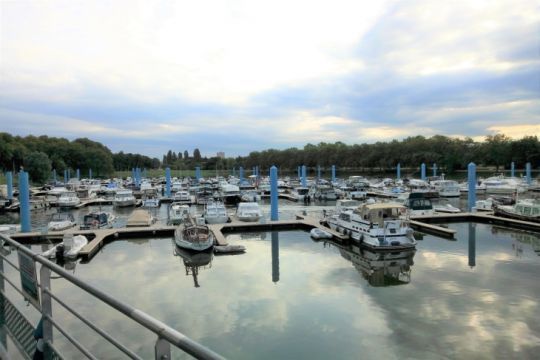
" You can't miss the port of Mâcon, it is at kilometer 83, just on the right when you enter Mâcon. You can find all the services in Mâcon, including a black water pump (one of the only ones on the route) "explains Philippe, who can't help but add "The port of Macon is the most beautiful in France . Legend has it that he is from Mâcon and that his boat often stays there. Whatever the case, the port of Mâcon is particularly well equipped. 425 berths, a chandlery, mechanical workshops and all port services are available on site, including crane launching.
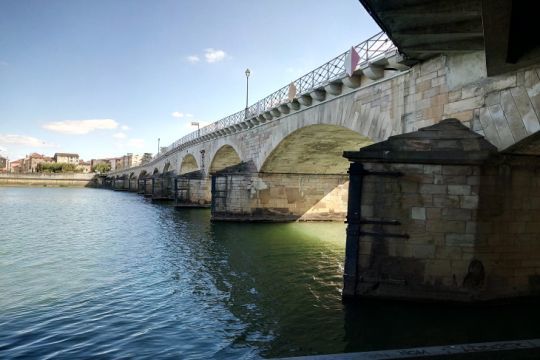
" The port of Macon is located 3 kilometers from the city center, that's its disadvantage "Philippe acknowledges. " If you absolutely want to moor more in the center, it is possible to do it after the Saint-Laurent bridge, along the Lamartine esplanade. For the day only, because it is noisy in the evening and at night "says the connoisseur.
Before arriving at the Saint-Laurent bridge, on the left bank, is the city of Saint-Laurent-sur-Saône. It also offers a dock without services. Near the port, there are bars and restaurants. "It's a little quieter than the other side, during the day at least. At night, it's a party den!"
Nevertheless, in Mâcon itself, you will find all the shops and services. The city is very beautiful to visit. Not to be missed, the tourist office of Mâcon proposes thematic tours ( Mâcon Monumentale, Mâcon Insolite, Les Contes D'apothicaire or Mâcon By Wine ).
" When leaving Macon, you have to be careful because you will cross a lot of commercial traffic "warns Philippe.
A few more kilometers to reach the bucolic and calm atmosphere of the river navigation.
A water stop is available near the campground, at kilometer 72. You can ski lift on the pond next to the rest stop, among other water activities.
Finally, at the Thoissey bridge (point 63), " take on the left a river called the Chalaronne. About fifty meters further down you will find a quiet and soothing river stop. "Be careful, the passage under the bridge is quite low ( less than 3 meters ) and the relatively modest depth ( less than 2 meters ).
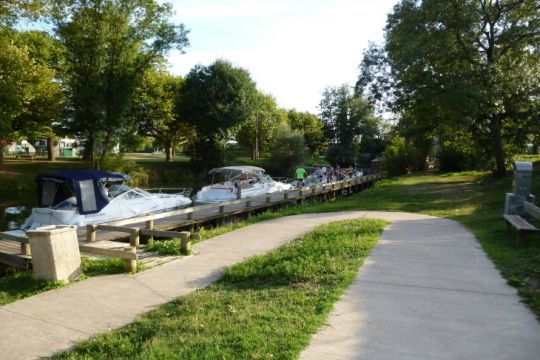
Local tips and tricks
The banks of the Saône are a surprising succession of extremely dense industrial zones, small green areas and almost deserted zones. If the navigation remains steady, there are plenty of places to stop for an hour or a night.
This is the case, for example, at the Cergy river stop which, in summer, offers a joyful and lively guinguette. " Mouth watering this is the name of the place and it is ideal for a late afternoon drink. "
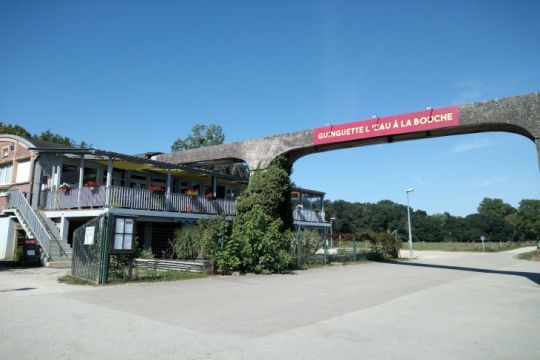
" In Châlons-Sur-Saône, there is a multitude of restaurants especially on the side of the Saint-Laurent island. You have to leave the island by a footbridge which leads directly to the city center which you must visit "Philippe insists that before his well-deserved retirement, he ran a restaurant in town.
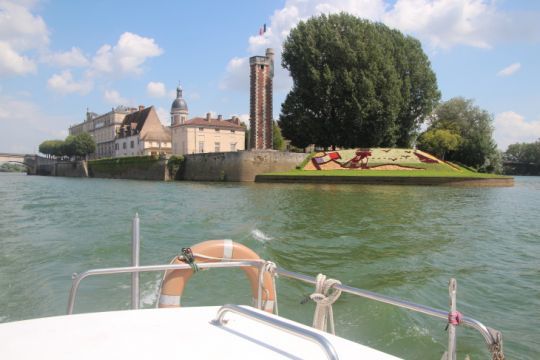
Tournus was, at one time, the most star-studded city ( in the Michelin guide sense of the term ) in the world. There were no less than 4 starred restaurants for 6,000 inhabitants! " To indulge yourself, the Greuze, the rampart and the terraces. There are also more family and affordable restaurants in town "continues Philippe.
But to limit Tournus to gastronomy would be to do an injustice to this beautiful medieval city, its abbey, its market and the crowd of passages and alleys that one must visit. " The best way to visit Tournus is to get lost! " we say.
Even if it doesn't look like much, " the restaurant of the port of Asnière-Sur-Saône is worth a stop, the floating pontoon gives direct access. "
In Vézines, the restaurant la guinguette à papa has its own floating pontoon. The stop is compulsory, calm and in good spirits.
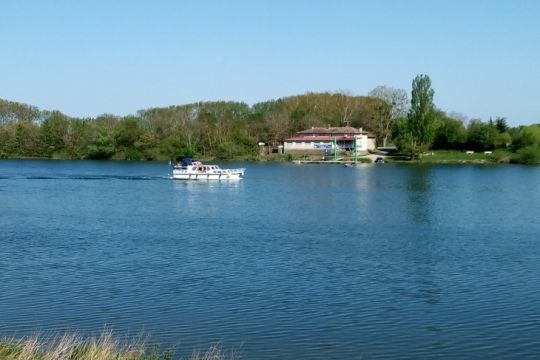
For a time more or less abandoned, the restaurant Les Mouettes in Mâcon, has been modernized and has created a really nice atmosphere of relaxation.
A little further down, around St. Laurent and the eponymous island, there is no shortage of bars and restaurants, " with the lot of noise and revelers that this generates "says the Mâconnais.
Although it is mainly suitable for small boats, " there is a restaurant in the port of Saint-Romain-Des-Iles ( The bridge restaurant ) among the best frog legs in the region " according to one batrachian enthusiast.
A river well equipped for professionals
" On the whole, the harbours and marinas are of good quality, at least technically " explains the boater. " Because the river is very busy and there is a lot of traffic, it is necessary to pay attention during navigation and, more than anything, to follow the nautical instructions, whether they are on the map or on the signs, because there are many pitfalls. In some places, the Saône is largely silted up. These sandbanks are all marked and you should pay attention to them. "
In Macon, the widest point of the river, there are more than 300 meters separating each bank. " The Saône is referred to as a lazy river because its dimensions give this impression. "And also because, except when approaching dams or confluence zones, the current is quite weak on the whole course.
Very commercial river, fuel, water and electricity are easily found, less easily black water pump on the course.
Navigation on this stretch of the Saône may require some attention, it has some very nice surprises and one should not be disappointed by the sometimes overly developed appearance of the banks. Each large city, each industrial zone or each factory quickly gives way to a piece of greenery that is as soothing and calm as the city can be teeming.
The Grande Saône in brief
- Length: 122 kilometers
- Locks : 5
- Speed limit: 8 - 15 - 30 km/h depending on the zone (Signage in place)
- Border crossing : No
- Vignette / navigation tax : Yes (VNF)
- Managing institution: Voies Navigables de France
- Renters : Saône Bateaux - Crisboat - Locaboat - Nicols - Les Canalous
- Departments : Vosges, Haute Saône, Côte-d'Or, Saône-et-Loire, Ain and Rhône
- Minimum air draft : 4,90 meters
- Minimum draught : 3,50 meters
- Period of unemployment: None
- Smartphone application : No
- Information website: https://navigation-saone-mediterranee.vnf.fr/

 /
/ 